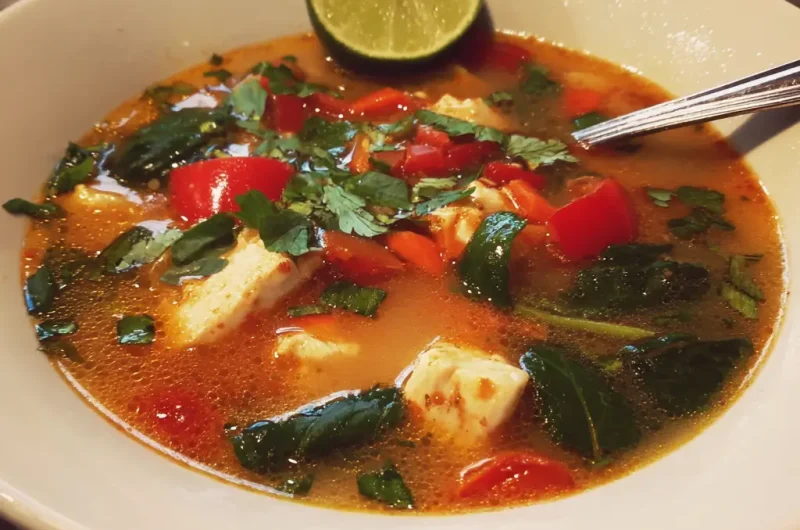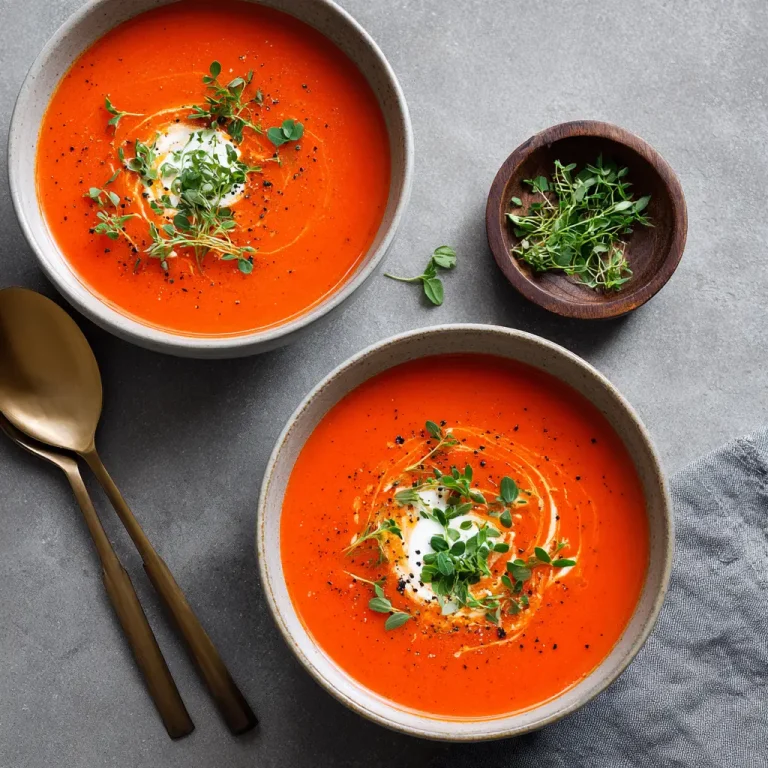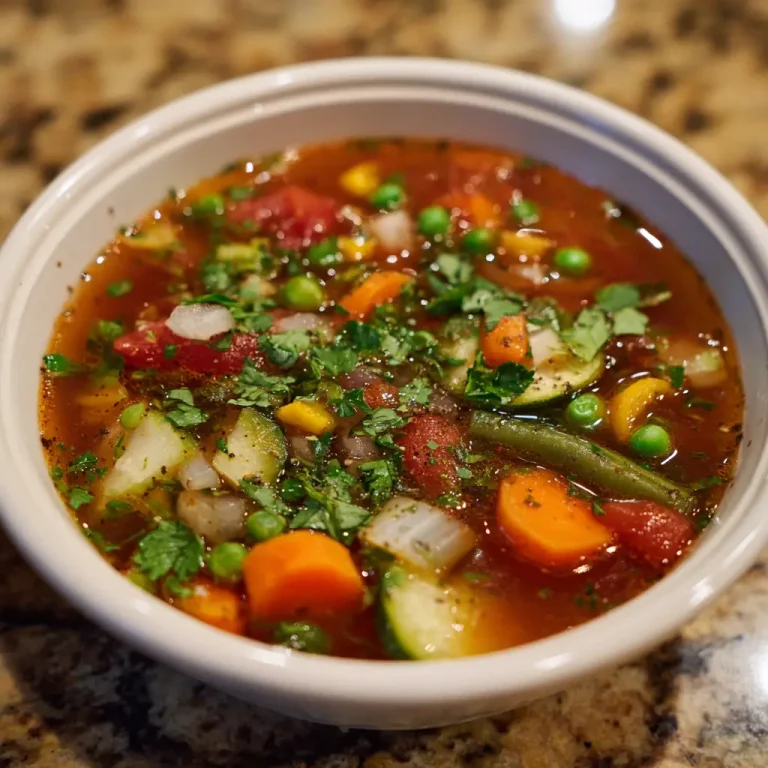Thai Soup Recipe | Authentic Thai Flavors in Every Bowl
Introduction
A warm bowl of Thai soup captures the heart of Thailand’s vibrant cuisine. The balance of spicy, sour, sweet, and salty flavors tells a story of culture and tradition that has evolved over centuries. Every sip takes you through the bustling markets of Bangkok and into the comfort of a Thai home kitchen. What makes Thai soup so special is its simplicity combined with complexity of taste. The fresh herbs, fragrant coconut milk, lemongrass, lime leaves, and chili paste all work together to create something deeply satisfying.
Unlike many soups that rely on heavy cream or thick broths, Thai soups feel light yet filling. They awaken your senses without weighing you down. You can enjoy them as a starter or a full meal, depending on how you prepare them. Whether you are a beginner home cook or an experienced food lover, learning how to make an authentic Thai soup is both rewarding and enjoyable.
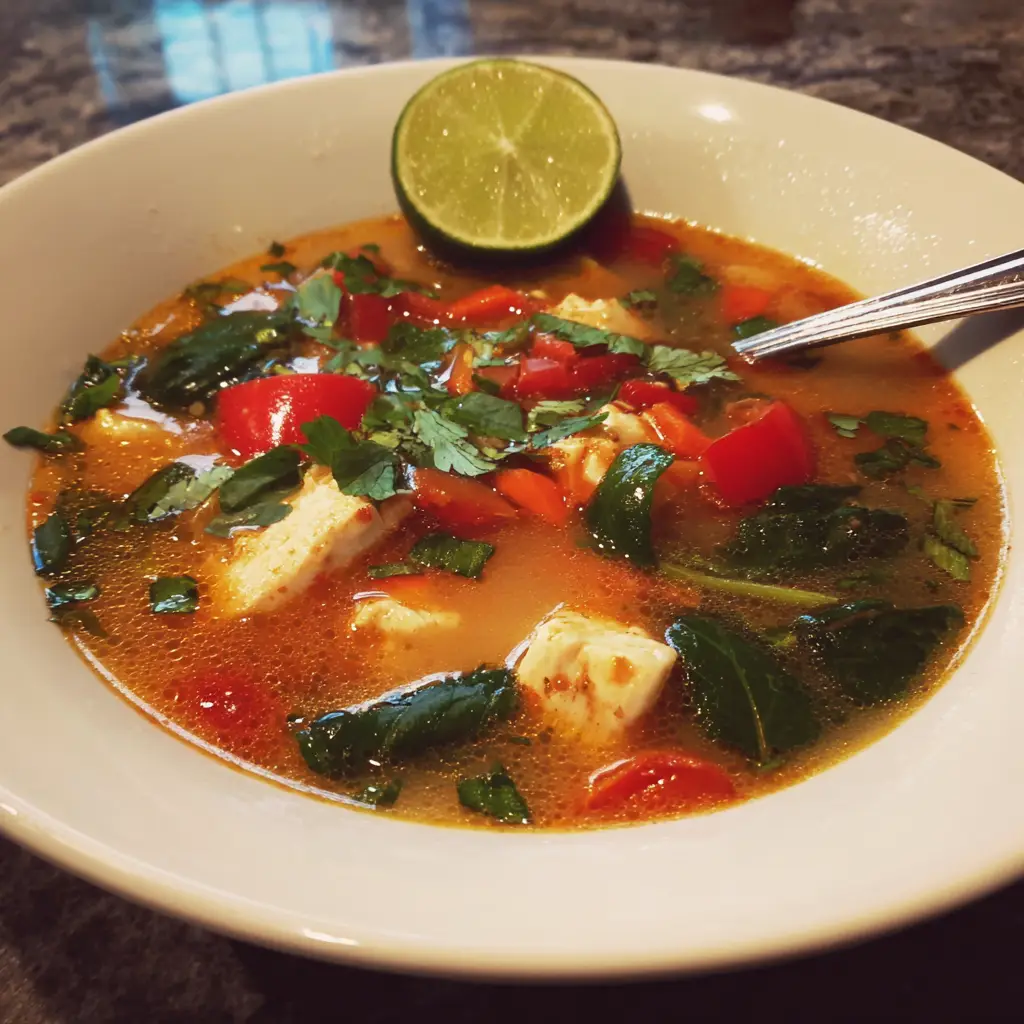
Thai soup is also incredibly versatile. You can keep it vegan by using tofu and vegetables or make it heartier with shrimp, chicken, or fish. The key is to respect the balance of flavors that defines Thai cooking. Once you understand the essence of these flavors, you can create endless variations that suit your own taste preferences.
In this guide, we will explore the ingredients, steps, tips, and nutrition that make Thai soup a perfect comfort dish for any occasion.
Ingredients Needed
To make a classic Thai soup like Tom Yum or Tom Kha, you need fresh herbs, rich broth, and a few key pantry staples. Below is a table that lists essential ingredients along with their estimated calorie counts per serving.
| Ingredient | Quantity | Approximate Calories |
|---|---|---|
| Chicken or vegetable broth | 4 cups | 60 |
| Coconut milk | 1 cup | 150 |
| Lemongrass stalks | 2 stalks | 15 |
| Galangal (sliced) | 2 tablespoons | 10 |
| Kaffir lime leaves | 4 leaves | 5 |
| Thai red chili paste | 1 tablespoon | 25 |
| Fish sauce | 2 tablespoons | 20 |
| Fresh lime juice | 2 tablespoons | 10 |
| Mushrooms (sliced) | 1 cup | 30 |
| Shrimp or chicken | 200 grams | 180 |
| Cherry tomatoes | ½ cup | 20 |
| Fresh cilantro | 2 tablespoons | 2 |
| Thai chili peppers | 2 pieces | 10 |
| Brown sugar | 1 teaspoon | 15 |
| Green onions | 2 stalks | 10 |
These ingredients together build a perfect harmony of flavors—spicy, sour, creamy, and aromatic.
Step-by-Step Cooking Instructions
- Prepare the aromatic base
Begin by trimming and crushing the lemongrass stalks to release their oils. Slice the galangal thinly and tear the kaffir lime leaves slightly to help them release flavor. These three ingredients form the soul of your Thai soup. - Boil the broth
In a large pot, add your chicken or vegetable broth. Bring it to a gentle boil, then add lemongrass, galangal, and lime leaves. Let them simmer for ten minutes so the flavors infuse deeply into the broth. - Add the protein and vegetables
Once your broth smells fragrant, add shrimp, chicken, or tofu along with mushrooms and cherry tomatoes. Cook until the protein is done and the vegetables are tender but not mushy. - Incorporate coconut milk
Pour in the coconut milk and stir gently. Allow it to simmer for five minutes. Avoid boiling it vigorously, as that can separate the coconut milk. - Season to taste
Stir in the fish sauce, chili paste, lime juice, and a small pinch of brown sugar. Taste and adjust the balance of flavors. If it feels too sour, add a bit more sugar. If it feels too creamy, balance with extra lime juice. - Finish with herbs
Remove the lemongrass and galangal slices. Sprinkle chopped cilantro and sliced green onions on top before serving.
The entire cooking process takes about thirty minutes, making this soup ideal for busy days when you crave something flavorful yet quick to prepare
.
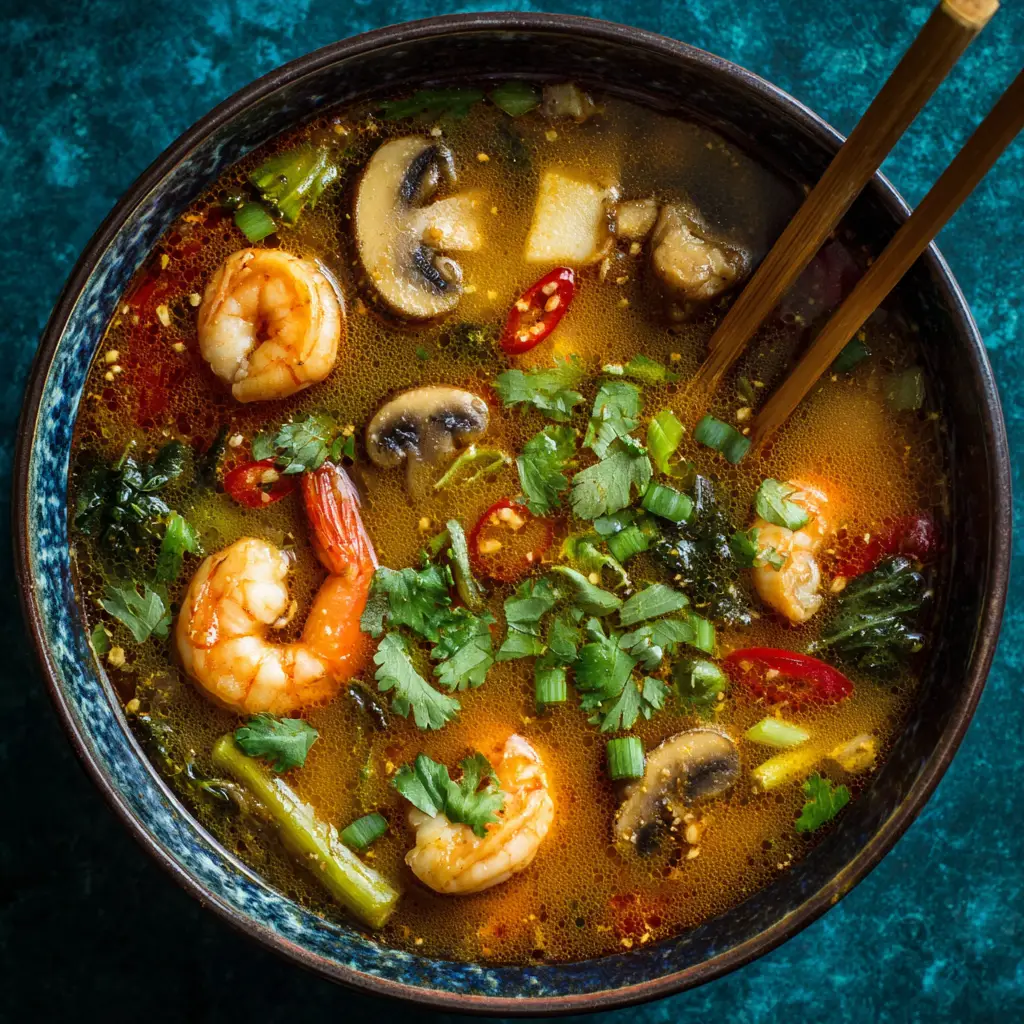
Tips for Customizing the Recipe
Thai soup is one of the most flexible dishes you can make. You can easily modify the base recipe to match your dietary needs or personal preferences.
- For a vegetarian version, use vegetable broth and replace fish sauce with soy sauce or mushroom sauce.
- To make it spicier, add more Thai chili peppers or a spoon of chili oil.
- For a lighter soup, reduce the coconut milk and increase the broth.
- To make it richer, use full-fat coconut milk and add a small spoon of peanut butter for a nutty flavor.
- For a seafood twist, include calamari, mussels, or white fish instead of chicken or shrimp.
- Add noodles to transform your Thai soup into a full meal. Rice noodles or glass noodles work best.
Experimentation is part of the Thai cooking experience. The goal is to find a balance that pleases your palate.
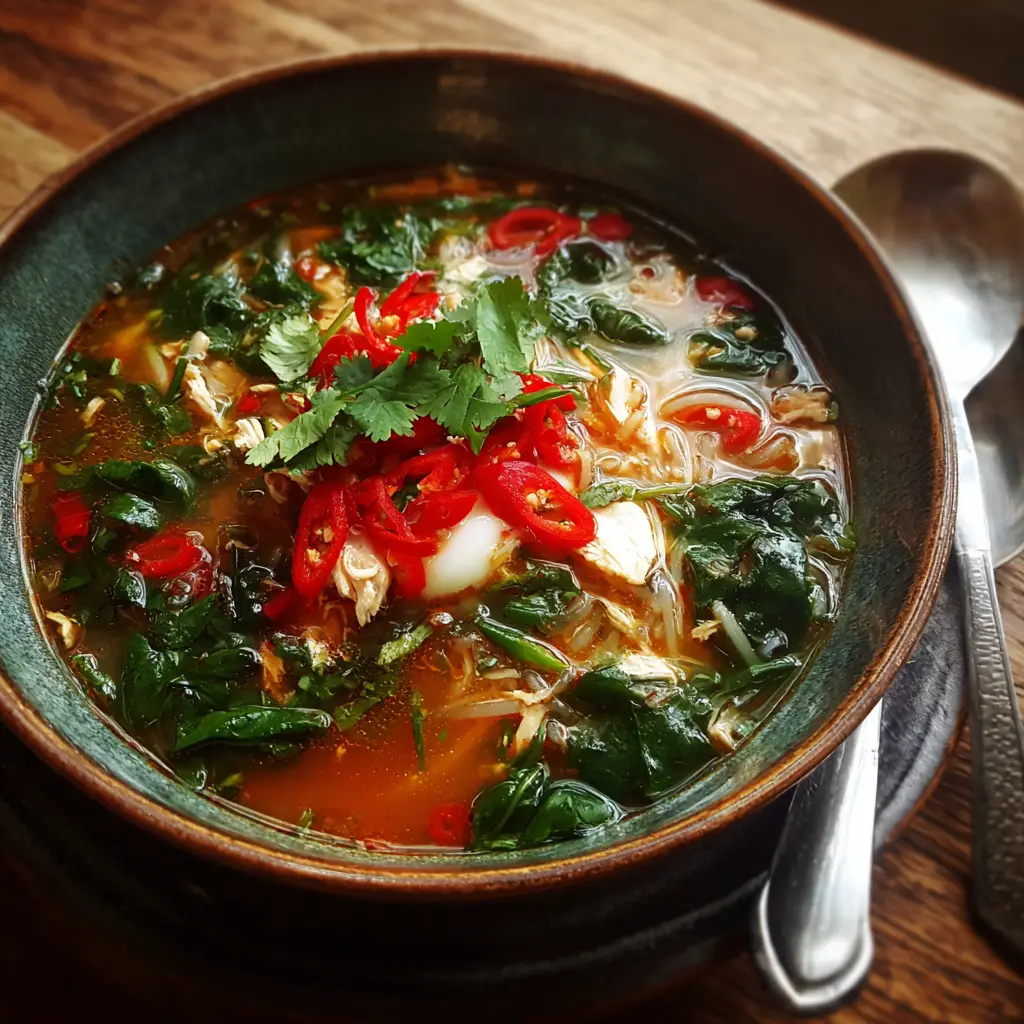
Nutritional Information
A single serving of Thai soup provides a well-balanced mix of nutrients. Here’s an approximate breakdown per serving:
Despite its rich flavor, Thai soup remains relatively low in calories compared to many creamy soups. The use of herbs and spices boosts its nutritional value while supporting digestion and immunity.
Serving Suggestions
Thai soup tastes best when served hot. You can pair it with steamed jasmine rice or enjoy it as a starter before a main Thai dish such as Pad Thai or Green Curry. For an authentic touch, serve the soup in deep bowls with fresh lime wedges and extra chili flakes on the side.
If you are hosting guests, garnish the soup with a swirl of coconut milk and a sprinkle of chopped cilantro. The aroma alone will impress everyone at the table. It also pairs beautifully with light appetizers like Thai spring rolls or papaya salad.
For a comforting weeknight dinner, keep the soup simple. A side of sticky rice or crispy tofu will make the meal complete.
Thai Soup Recipe | Authentic Thai Flavors in Every Bowl
Course: Blog4
servings15
minutes25
minutes280
kcalIngredients
4 cups chicken or vegetable broth
1 cup coconut milk
2 stalks lemongrass (trimmed and crushed)
2 tablespoons sliced galangal (or ginger if unavailable)
4 kaffir lime leaves (torn slightly)
1 tablespoon Thai red chili paste
2 tablespoons fish sauce (or soy sauce for vegetarian)
2 tablespoons fresh lime juice
1 cup sliced mushrooms
Directions
- Prepare the aromatic base
- Crush the lemongrass and slice the galangal. Tear the kaffir lime leaves to help release their natural oils.
- Make the broth
- In a large pot, bring the chicken or vegetable broth to a gentle boil. Add lemongrass, galangal, and lime leaves. Let them simmer for about 10 minutes to infuse flavor.
- Add protein and vegetables
- Add the shrimp or chicken along with mushrooms and cherry tomatoes. Cook until the protein is fully cooked and vegetables are tender.
- Add coconut milk and seasoning
- Pour in the coconut milk, then add Thai red chili paste, fish sauce, lime juice, and brown sugar. Stir well and let it simmer for 5 more minutes over low heat.
Recipe Video
Notes
- For a vegetarian version, replace the fish sauce with soy sauce or mushroom sauce and use tofu instead of chicken or shrimp. You can also add rice noodles to make it a hearty one-bowl meal. Always use fresh herbs for the most authentic Thai flavor.
FAQs About Thai Soup
Q1: Can I store Thai soup for later use?
Yes, you can refrigerate Thai soup for up to three days. Reheat it gently on the stove. Avoid boiling to preserve the creamy texture of coconut milk.
Q2: Can I freeze Thai soup?
Freezing is possible, but it is best done without the coconut milk. Add it fresh when reheating to prevent separation.
Q3: How do I make it gluten-free?
Replace soy sauce with tamari or gluten-free fish sauce. Most other ingredients are naturally gluten-free.
Q4: What makes Thai soup different from regular soups?
The distinct combination of lemongrass, galangal, and lime leaves gives Thai soup its signature aroma. The balance of sweet, sour, salty, and spicy flavors sets it apart.
Q5: Can I make Thai soup without coconut milk?
Yes, simply use more broth and increase lime juice slightly for brightness. It will have a lighter and clearer texture.
Conclusion
A bowl of Thai soup brings warmth and comfort no matter the season. The delicate blend of spices, herbs, and fresh ingredients reflects the spirit of Thai cooking—simple yet full of depth. Preparing it at home allows you to explore new flavors while nourishing your body and soul. With each spoonful, you experience a harmony that feels both exotic and familiar. So, gather your ingredients, take a deep breath, and let the aroma of lemongrass fill your kitchen.

